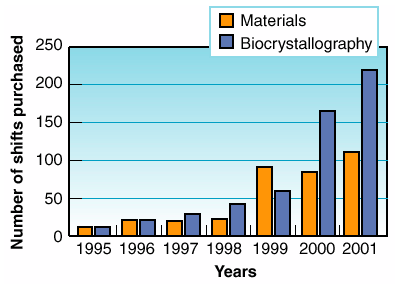Introduction
Applied and industrial work carried out at the ESRF consists of both confidential and non-confidential research. In general, the confidential work is directly carried out by companies, whereas the non-confidential work is carried out by public institutions, who are often working in collaboration with companies. Beam time allocation for non-confidential research follows the same rules as for public research: it has to be approved by a review committee, it is free of charge and the results must be published. For confidential research, the beam time is charged and publication of the results is not required. This non-reviewed procedure permits rapid access, which is a very important factor for many industrial projects.
Commercial activities
As in previous years, there was a substantial increase in beam time sold during the year 2000: more than 230 shifts were purchased, which represents an increase of 50% with respect to 1999 (Figure 123). Biocrystallography data collection is by far the major activity (about 2/3).
 |
Fig. 123: Number of purchased shifts (est. for 2001).
|
The ESRF beamlines attract pharmaceutical companies due to their excellent performances and the efficient organisation which assists the users both during and after their experiments. Interestingly, in addition to the dozen large European pharmaceutical companies, there were several new start-up companies acting on behalf of these larger companies, who also made use of the bio-crystallography beamlines. One example of a pharmaceutical project is described in the contribution "Structure of a Low-Affinity Penicillin-binding Protein from Enterococcus Faecium". Activity in Industrial biocrystallography is expected to increase again during the year 2001. We are considering the launch of a dedicated complete service for data collection and data treatment, thus avoiding time-consuming travel for industrial bio-crystallographers.
The second most significant confidential activity is microtomography. The demand for imaging the three-dimensional structure of industrial objects in fields as varied as healthcare products, plastics, rocks, or alloys and composites, has greatly increased. The purpose is either to detect defects (tiny fractures or voids) in the bulk, or to study the porosity or architecture of foam-like materials. This activity is run as a full service carried out by an engineer, including data collection and data processing. A spectacular application of time-resolved tomography is given in the contribution "In situ Real-time Radiography for Process Optimisation Foaming of Metals".
Another important commercial activity will obtain full momentum in 2001, the measurement of trace element contamination on silicon wafers by total X-ray reflection fluorescence. A dedicated station was built within the framework of the MEDEA European program. The use of synchrotron radiation permits microelectronic companies to measure lower contamination levels than by using conventional X-ray sources, which is now required by new technologies in the semiconductor industry. The reader will find a description of the facility in the contribution which follows "ID27 - An industrial SR-TXRF facility opens its doors to the semiconductor community".
Non-commercial activities
Applied and industrial non-confidential activities represent about 20% - 25% of the overall beam allocation at the ESRF. They concern various industrial domains such as microelectronics, polymers, metallurgy, and also fine chemicals, the oil industry, building materials, pulp or cosmetics. These activities mainly benefit from the micro-analytical analyses at the micrometre scale (fluorescence, diffraction) and from the imaging techniques, and also from absorption spectroscopy, surface analyses, high-resolution diffraction and magnetism-related techniques. Several contributions in the present issue give an idea of the wide variety of these applied topics which include basic research of new materials, process development or control:
- "X-ray diffraction with nanometric spatial resolution" (micro-diffraction/microelectronics)
- "In situ X-ray microscopic study of electromigration" (X-ray microscopy/microelectronics)
- "Relaxation in doped strained layers of compound semiconductors" (topography/optoelectronics)
- "Anomalous Co segregation and its influence in the magnetoresistance of CoxCu100x granular alloys" (EXAFS-diffraction/microelectronics)
- "Nano-tomography on self-assembled quantum dots" (surface diffraction/microelectronics)
- "Monolayer-resolved magnetic moment profile in Ni/Pt multilayers" (XMCD-XANES/magnetic materials)
- "Micro-SAXS from polyurethane foams" (micro-diffraction/plastics)
- "Friction stir-welding" (strain/stress analysis/metallurgy)
- "Surface study of hardened layers in steels" (EXAFS/metallurgy)
The scientists involved in these activities originate frequently from academic institutions that work in very close collaboration with industry. In many cases, techniques are explored which can later result in commercial, confidential activities once the usefulness of the technique has been established.



